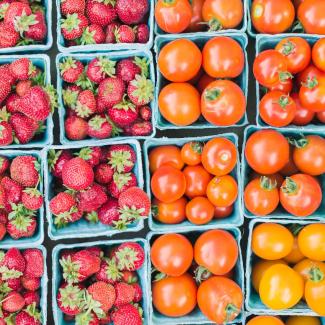
How to Reduce Pesticide Exposure
Growing up in the Salinas Valley, I was very fortunate to see first hand how my food was grown and where it came from. Driving down Highway 68, I not only got to see the beautiful lupin in the springtime, but also the very produce that would eventually make its way onto my plate. As a Salinas native and former long time resident, I started to take more of an interest in how my food was grown and the processes by which that happened. This led me to discover more about organic and sustainable farming and the local companies that implement these practices. I would like to share with you why organic and pesticide-free farming is crucial for your and your family’s health and how it prevents many health problems we see today.
Many people think that organic produce is a gimmick and that it’s “all the same” from conventional produce. Harvard University has studied this topic and ran tests on congenitally grown produce to test for either high or low pesticide levels. Thus far, they have found that the pesticide exposure in fruits and vegetables can actually outweigh the benefits one would experience when consuming such foods. They also found that people who consumed more pesticide heavy foods had higher concentrations of these pesticides in urine tests as opposed to people who ate foods with a lower pesticide exposure. Why this matters is that one of the main herbicides used in farming, glyphosate, has been linked to cancer and has actually been proven in court. Harvard researchers found that after several days of eating organic or low pesticide foods, detectable levels of pesticides in urine levels (the best test we have for this) dramatically declined. This is very encouraging because this is one of those easy swaps you can make that will render immediate results. Some of the risks that are reduced when you make the switch include improved fertility and birth outcomes, BMI, and a reduced risk of Non-Hodgkin Lymphoma and Type 2 Diabetes. Also, considering the growing rates of cancer in the US, this is a particular area of interest for me.
Every year, USDA produce is tested for their pesticide levels and each year, the data is updated to reflect the findings. The Environmental Working Group and Harvard University practice similar testing methodology when testing the produce. It was found that even after being washed and scrubbed, the produce with high pesticide exposure still had these chemicals intact on the produce that then went out to the consumer. Two lists that help take the guess work out of choosing the best produce to purchase are the Dirty Dozen and Clean 15 from the EWG. Make sure to get the current year’s findings and keep the lists handy as you buy your groceries. The Dirty Dozen are the types of produce that contain the highest detectable levels of pesticides, and conversely, the Clean 15 had either none or the lowest levels. If you do nothing else, try to buy as many fruits and vegetables on the Dirty Dozen list organic as possible and then continue buying conventional grown produce from the Clean 15 list.
Dirty Dozen List 2022:
- Strawberries
- Nectarines
- Bell & Hot Peppers
- Pears
- Spinach
- Apples
- Cherries
- Celery
- Kale, Collard & Mustard Greens
- Grapes
- Peaches
- Tomatoes
Clean 15 List 2022:
- Avocados
- Onions
- Asparagus
- Cabbage
- Mangos
- Sweet Corn
- Papaya
- Honeydew Melon
- Mushrooms
- Watermelon
- Pineapple
- Sweet Peas (frozen)
- Kiwi
- Cantaloupe
- Sweet Potatoes
How to Shop for Low or Non-Pesticide Produce
The best and most ideal way to eat is local, seasonal, and organic. Your options are going to a farmer’s market, visiting a farm in person, or a subscription produce box from a local organic farm. All of these options help you personally get to know the people growing your food and eat according to what’s in season. Your food also is not traveling very far or on a truck for days at a time before it arrives to you. I personally find local organic food to be far superior in both quality and taste. I look forward to eating my fruits and vegetables from these sources and end up consuming more as a result.
Check out localharvest.org for a a CSA (community supported agriculture) subscription box of organic produce that you can either pick up locally or have delivered right to your door. You also have the option to customize the type of box you want or need as well as frequency of your subscription.
The next best option is to simply shop for organic produce at your local grocery store. This is the easiest, fastest, and most convenient option. You can buy your conventionally grown and organic produce all in one place with your other grocery items and doesn’t change too much from how you already may be shopping. Try both options out and see what works best for you.
This is one of the easiest and best investments in both the short and long term with improving health outcomes. Eating will also become more fun and enjoyable as you learn about and try new produce you may not be used to eating and experimenting with fun new recipes, too!

